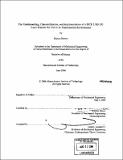| dc.contributor.advisor | Ernesto Blanco. | en_US |
| dc.contributor.author | Berrios, Marcos (Marcos Gabriel) | en_US |
| dc.contributor.other | Massachusetts Institute of Technology. Dept. of Mechanical Engineering. | en_US |
| dc.date.accessioned | 2007-02-21T13:24:16Z | |
| dc.date.available | 2007-02-21T13:24:16Z | |
| dc.date.copyright | 2006 | en_US |
| dc.date.issued | 2006 | en_US |
| dc.identifier.uri | http://hdl.handle.net/1721.1/36299 | |
| dc.description | Thesis (S.B.)--Massachusetts Institute of Technology, Dept. of Mechanical Engineering, 2006. | en_US |
| dc.description | Includes bibliographical references (p. 31). | en_US |
| dc.description.abstract | With technology growing at an alarming rate the need for precise measurement equipment has also intensified. One such device is the SICK Laser Measurement System (LMS). Based on a time-of-flight measurement principle, this sensor allows for centimeter resolution. This thesis presents a basic understanding and characterization of the laser measurement system necessary for successful implementation into an experimental environment. A personal computer to LMS software interface is also presented. The SICK Company provides software for acquisition which displays a scanned profile in real time, but it does not have the provision for saving the acquired image and corresponding data, nor is it suited for on demand modifications such as actively setting the operation mode of the LMS. Having software to handle the communication between the LMS and PC that can be seamlessly integrated into an experimental environment is essential. The laser scanner then becomes an onboard sensor with the capability of sourcing real time data for use in pose estimation or an online control algorithm, among other possibilities. | en_US |
| dc.description.abstract | (cont.) To further expand the profitability of the range sensor in the incorporation of experiments, a MATLAB GUI that is able to dynamically localize the LMS with respect to a given coordinate system was created. Self localization of the laser scanner allows for more complex experimental setups without the need of cumbersome and often inaccurate human based measurements. | en_US |
| dc.description.statementofresponsibility | by Marcos Berrios. | en_US |
| dc.format.extent | 47 p. | en_US |
| dc.language.iso | eng | en_US |
| dc.publisher | Massachusetts Institute of Technology | en_US |
| dc.rights | M.I.T. theses are protected by copyright. They may be viewed from this source for any purpose, but reproduction or distribution in any format is prohibited without written permission. See provided URL for inquiries about permission. | en_US |
| dc.rights.uri | http://dspace.mit.edu/handle/1721.1/7582 | |
| dc.subject | Mechanical Engineering. | en_US |
| dc.title | The understanding, characterization, and implementation of a SICK LMS-291 laser scanner for use in an experimental environment | en_US |
| dc.type | Thesis | en_US |
| dc.description.degree | S.B. | en_US |
| dc.contributor.department | Massachusetts Institute of Technology. Department of Mechanical Engineering | |
| dc.identifier.oclc | 77744013 | en_US |
